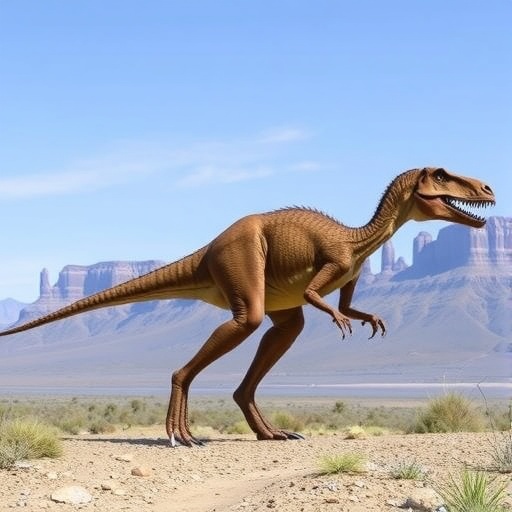In a groundbreaking discovery that reshapes our understanding of dinosaur evolution during the Late Triassic epoch, paleontologists have unearthed a remarkable new fossil assemblage in northwestern Argentina. This assemblage, found within the previously unrecognized Northern Precordillera Basin, offers compelling insights into the diversification and anatomical innovations of early dinosaur lineages approximately 230 million years ago. Among the richly fossiliferous remains, the near-complete skeleton of a newly described sauropodomorph dinosaur, named Huayracursor jaguensis, stands out for its distinctive morphology, suggesting an evolutionary intermediate stage in both body size and neck elongation.
The Late Triassic, spanning roughly 237 to 201 million years ago, was a pivotal interval marked by dramatic faunal turnovers and the initial radiation of many vertebrate clades that would come to dominate the Mesozoic terrestrial ecosystems. Particularly, the rise of mammaliaforms, crocodile-line archosaurs (crocodylomorphs), and the earliest dinosaurs occurred within this dynamic environmental and ecological framework. South American Carnian deposits have been central to this narrative, providing crucial fossil material principally from well-studied regions such as the Ischigualasto-Villa Unión and Paraná basins. Historically, these basins have yielded some of the earliest dinosaur remains and diversely sampled contemporaneous vertebrate taxa, yet geographic sampling bias has left other fossiliferous basins relatively unexplored.
The discovery at the Quebrada Santo Domingo site within the Northern Precordillera Basin represents a significant extension of this biogeographic and paleontological framework. The fossils retrieved exhibit a striking taxonomic and ecological breadth, featuring key Late Carnian taxa such as hyperodapedontine rhynchosaurs—herbivorous archosauromorphs known for their robust jaws—gomphodontosuchine traversodontid cynodonts, early mammal relatives indicative of advanced herbivory, and heavily armored aetosaurs, which filled unique ecological niches. This diversity underscores an unexpectedly complex Late Triassic ecosystem in this region that parallels yet is distinct from neighboring basins.
The centerpiece of this assemblage is Huayracursor jaguensis, a novel genus and species of early sauropodomorph dinosaur that challenges pre-existing characterizations of Late Carnian dinosaurs. Unlike other known Carnian sauropodomorphs, which tend to be relatively small with stocky, short necks, Huayracursor exhibits an unprecedented increase in body size combined with an initial elongation of the cervical vertebrae. This anatomical trait is particularly significant as it represents an evolutionary intermediate condition bridging the morphological gap between small-bodied Carnian sauropodomorphs and the more derived, larger-necked genera known from the subsequent Norian stage of the Late Triassic.
The morphology of Huayracursor provides a unique window into trends of gigantism and neck elongation that became hallmarks of later sauropodomorph radiation, ultimately leading to the colossal long-necked sauropods of the Jurassic and Cretaceous. The vertebral elongation observed appears to be an early experimental adaptation possibly linked to ecological pressures such as optimized foraging strategies or enhanced browsing height. This discovery, therefore, offers a rare glimpse into the incremental anatomical modifications that presage the outstanding sauropodomorph body plans that would dominate dinosaurian herbivory for tens of millions of years.
The thorough preservation of the Huayracursor specimen facilitates detailed osteological analysis that confirms its basal phylogenetic position within Sauropodomorpha while highlighting its mosaic of primitive and derived characters. Compared with its contemporaneous counterparts, Huayracursor displays more gracile limb proportions and distinctive vertebral elongation patterns that hint at functional shifts in locomotion and feeding behaviors. These data collectively emphasize the evolutionary experimentation occurring during the Late Triassic, an era previously assumed to have relatively conservative dinosaur morphotypes.
This research also contributes novel paleobiogeographic perspectives concerning dinosaur evolution in Gondwanan landmasses. The Northern Precordillera Basin, now well established as a Late Triassic fossil source, reveals that dinosaur faunas were more widely distributed and ecologically varied than previously documented. Such findings call into question notions of faunal provincialism and highlight complex patterns of dispersal and niche partitioning during critical intervals of vertebrate evolution on Pangaea.
Furthermore, the assembly of associated vertebrates, including rhynchosaurs and traversodontid cynodonts, complements emerging evidence that Late Triassic terrestrial ecosystems comprised tightly knit communities involving diverse herbivore and omnivore guilds. The coexistence of herbivorous aetosaurs alongside early dinosaurs and mammaliaforms suggests robust trophic interactions and evolving food webs, shedding light on ecosystem complexity long before the dominance of dinosaurs in the Jurassic.
The geological context of the Northern Precordillera Basin, dating to the Carnian stage of the Late Triassic, provides a detailed temporal framework to examine evolutionary tempo and mode. This newly recognized basin underscores the importance of continued paleontological exploration beyond classical fossil sites, as it enhances our capacity to reconstruct faunal turnovers and morphological transitions across crucial intervals marked by climatic fluctuations and biotic upheavals.
In sum, the unearthing of Huayracursor jaguensis and its associated fauna solidifies the Northern Precordillera Basin as a key locale for understanding the earliest evolutionary stages of dinosaurs. The specimen bridges critical morphological gaps, illuminating pathways of neck elongation and size increase that would later define sauropodomorph success. These findings catalyze new research directions, prompting re-evaluation of Triassic dinosaur phylogeny and paleoecology, while invigorating interest in global Late Triassic faunal assemblages.
This breakthrough exemplifies how integrating detailed fieldwork with cutting-edge anatomical and phylogenetic analyses can revolutionize our grasp of deep-time evolutionary dynamics. With further excavations and multidisciplinary studies planned, the Northern Precordillera Basin promises to be a pivotal window into the origins and early diversification of the iconic dinosaurian lineage that reshaped terrestrial ecosystems for over 160 million years.
Subject of Research: Evolutionary morphology and ecosystem composition of Late Triassic terrestrial vertebrates, focusing on early sauropodomorph dinosaurs.
Article Title: A long-necked early dinosaur from a newly discovered Upper Triassic basin in the Andes.
Article References:
Hechenleitner, E.M., Martinelli, A.G., Rocher, S. et al. A long-necked early dinosaur from a newly discovered Upper Triassic basin in the Andes. Nature (2025). https://doi.org/10.1038/s41586-025-09634-3
Image Credits: AI Generated




